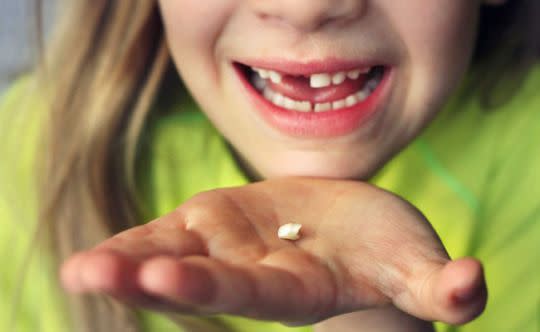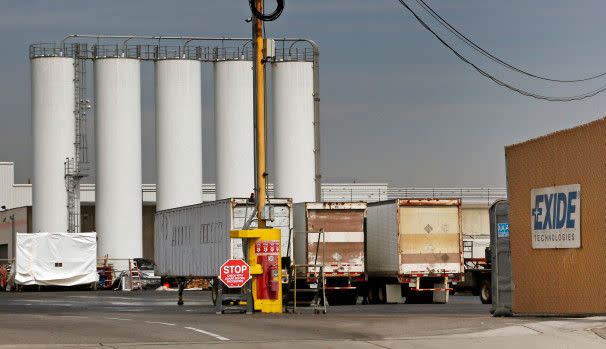Why recycling dead batteries could be leading to lead in baby teeth

Most people don't give a thought to what happens to their old car, boat or golf cart battery after it dies, but nearly all are broken down for valuable parts and chemicals at industrial smelters.
But what's left in the soil, air and water, both while facilities are operating, and after they shut down are a cause for concern.
A new study documents dangerous lead in the baby teeth of 100% of babies and children tested downwind of a now closed battery smelter in southeastern Los Angeles, often absorbed when their mothers were pregnant and the plant was still operating.
Lead is a potent neurotoxin that can cause low birth rates as well as brain damage, attention deficits and other problems in growing children, and high blood pressure and kidney disease in adults, with deposits sinking in to bones and teeth.Scientists say there are no known safe levels.
"All the kids we tested that grew up in this community had detectable levels of lead," said corresponding author Jill Johnson, an assistant professor of preventive medicine with the University of Southern California Keck School of Medicine. "Two things really stand out: we see this exposure starting in utero, so transmission of these contaminants from moms to kids is important in these industrial areas. And we see a significant correlation between lead contamination in soil and levels in teeth."
Explore: Where are some of the smelting plants in the nation?
Exide, the plant’s owner and one of the world's largest battery manufacturers and recyclers, has emitted lead into the skies in California, Pennsylvania, Texas, Indiana, Kansas, Tennessee, and Missouri.
Lead, arsenic and other contaminants blown from smokestacks can end up in the air and nearby playgrounds, front or backyards or other outdoor areas, passing first from mothers breathing it to their unborn children, and then settling into soil where toddlers or pets may crawl or play in it and track it inside.
![Presto ID 197209 CAPTION: Contaminated soil and house dust are significant sources of lead poisoning for children, who ingest lead particles when they put dust-covered fingers and toys in their mouths. A recent USA TODAY investigation of soil around old lead factory sites found potentially dangerous levels of lead in nearby yards, including in the soil beneath this tricycle in Minneapolis. [Via MerlinFTP Drop]](https://s.yimg.com/ny/api/res/1.2/mizo9.kOtIHnyclBEwrYaw--/YXBwaWQ9aGlnaGxhbmRlcjt3PTk2MDtoPTcyNQ--/https://media.zenfs.com/en-US/homerun/usa_today_news_641/b34417614893649c0013ded9639fa690)
"Lead tends to remain in the soil until it is removed – it does not readily biodegrade or dissolve," said Johnston, who is also reviewing dust near the polluted Salton Sea. "Lead and arsenic and a few other heavy metals are the biggest legacy concern for smelters."
"This is happening in many communities," said Mark Lopez with East Yard Communities, who helped collect the baby teeth used in the study. "I hope that when people look at this, they don't think, 'Oh, poor them.' They need to think, 'Are we being exposed too?'"
More: This city's air is killing people. Who will stop it?
Participants were not revealed, but area residents said the research proves what they've long suspected.
"My grandchildren were tested by their doctor for lead. One of them had high levels," said Teresa Marquez, 72, who lives two miles from the Exide plant, and whose daughter and grandchildren lived with her for several years.
The doctor told her daughter there was no treatment, all they could do was wait 30 days and re-test to see if his body cleared the toxic substance. Thankfully it did. But the little boy, then four years old, also suffered from severe asthma. "They went to Idaho for a trip, and he called me and said, 'Grandma, I can sleep and breathe all night long.' That's when my daughter knew she had to move."
The county health department visited her neighborhood, she said, and told residents to cover old, lead-based paint. But they didn't mention the lead battery facility.
Community activists who helped collect the teeth as part of the "Truth Fairy" project said while they're not surprised by the results, they're angry.
"What was most appalling, and to be honest, really makes my blood boil, is finding out that some of these spikes in exposures were happening in the third trimester of pregnancy," said Lopez. "Before a baby takes its first breath or its first step, it's already being exposed to lead for a long period of time."
He said while parents found it a bit weird to have scientists asking for their children's teeth, his group helped persuade them it was worthwhile. "We told them we can't give you a dollar to stick under the pillow, but we can help you find out the truth."
Analyzing baby teeth for lead is a novel method that has also been used in Boston, Sweden and Mexico. It's a less invasive way to test young children, and can help determine if exposure came from a facility that had since closed. While lead clears blood within 30 days, it stays stored in consecutive rings of teeth, like rings on a tree. The amounts found in Los Angeles and Mexican babies’ teeth near industrial areas were higher then in the European and Massachusetts children.
Exide spokeswoman Rebecca Harbin said in an email that the company "just learned off the USC study and is currently evaluating it."
But she said the company does not think it is responsible for widespread area contamination. She said researchers hired by Exide had done the only other study of soil in 2015 and found that high lead levels from the southern California plant is "confined to the industrial areas surrounding the facility and does not reach residential areas."
She said lead paint in older housing and car and truck traffic were the likely causes of lead in soil.
But Johnston noted that the study in Boston in a neighborhood of older homes found far lower levels of lead in children's teeth. Federal regulators and prosecutors in recent years charged Exide's southern California plant with violating environmental laws dozens of times, emitting illegally high levels of lead and other toxics.

A 2013 regional health assessment concluded 110,000 people faced elevated cancer risks from arsenic emitted by the plant. It operated under a temporary permit for more than a decade before signing an agreement with the U.S. Attorney's office and closing in 2015.
State agencies are still overseeing what is believed to be the largest clean-up in California history, with contractors slowly removing soil from an estimated 2,500 homes with the highest pollution in a 1.7 mile zone around the plant. They say there are no funds to clean thousands more homes that also have elevated levels.
Exide, based in Milton, GA, has also been charged with and sometimes fined for releasing lead and other contaminants into communities in other locations, including Reading, Pennsylvania; Frisco, Texas and Muncie, Indiana.
The company says it performs a valuable service and boasts on its website that "our commitment to recycling and environmental responsibility is unwavering."
More: Palm Springs one of the smoggiest spots in the US?
There is growing concern about what's left behind when such facilities close. A USA TODAY investigation in 2012 called "Ghost Factories" found lead from long-shuttered battery smelters is a major issue, with current landowners and area residents often unaware of past industrial uses and the contaminants that might still be present in soil. There are about 40 such facilities in California, said Johnston.
A request for comments from the Association of Battery Recyclers about the new study and safety in the industry was not returned. On its website, the group says that lead battery recycling is the single most successful recycling program in the nation, beating out newspapers, aluminum and tires, with more than 99 percent of batteries recycled. Many states mandate that dead batteries be returned to stores or dealers. The association and a sister group have in the past fought tougher regulations on smelters and lost. Some facilities, including the only one left in the western U.S., have installed improved pollution-capturing technology.
They also have said that it is safer to recycle batteries in the USA, which has stricter regulations, than in some other countries. But others say while the recycling is a valuable service, far more could be done to install protective equipment at facilities, and to design less polluting products.
"We’ve known for 100 years about the health impacts of lead, so it's time to think about new processes and new technologies and to think about phasing out lead," Johnston said.
Janet Wilson is senior environment reporter for The Desert Sun and writes the USA TODAY Climate Point newsletter. She can be reached at janet.wilson@desertsun.com or @janetwilson66
This article originally appeared on USA TODAY: Why recycling dead batteries could be leading to lead in baby teeth

